Sailfish
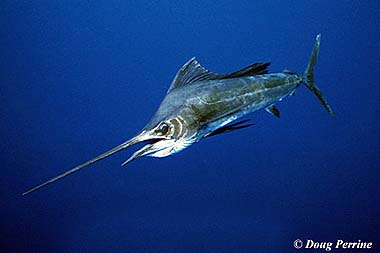
Istiophorus platypterus
The sailfish is one of the faster of the marine creatures, and one of the more popular in recreational fishing, despite the meat being of little value. This highly recognizable fish can grow to be over 10 feet long, including its elongated bill and its forked caudal fin. Its large first dorsal fin is usually taller than its body is and runs most of the length of its body. It is blue on top and white below, with rows of light blue dots, and its color can vary based on its excitement level.
Order: Perciformes
Family: Istiophoridae
Genus: Istiophorus
Species: platypterus
Common Names
English language common names include Atlantic sailfish, billfish, Indo-Pacific sailfish, ocean gar, ocean guard, Pacific sailfish, and sailfish. Other common names are abanico (Spanish), aguja (Spanish), aguja de abanico (Spanish), aguja vela (Spanish), atlanticheskii parusnik (Russian), atlantinperjekala (Finnish), atlantisk segelfisk (Swedish), atlantisk seifisk (Norwegian), bashokajiki (Japanese), bicuda (Portuguese), bicudo (Portuguese), caravela (Portuguese), dung dung (Wolof), espadarte-veleiro (Portuguese), espadon (French), espadon voilier (French), malan (Wolof), nishibashoo (Japanese), nishibashookajiki (Japanese), palagar (Spanish), parusnik (Russian), parusnik-ryba (Russian), peco (Portuguese), peixe andala (Portuguese), peixe de vela (Portuguese), peixe-vela (Portugese), pesce vela (Italian), pez vela (Spanish), pez vela de Atlantico (Spanish), pez vela del Indo-Pacifico (Spanish), prieta (Spanish), purjekala (Finnish), segelfisch (German), seilfisk (Norwegian), seilvis (Afrikaans), sejlfisk (Danish), squadron (French), veleiro-de-atlantico (Portugese), veleiro (Portuguese), veleiro do atlantico (Portugese), voilier de l’Atlantique (French), voiler de l’Indo-Pacifique (French), voladeira (Spanish), zegal-fisch (Dutch), and zeilvis (Dutch).
Importance to Humans
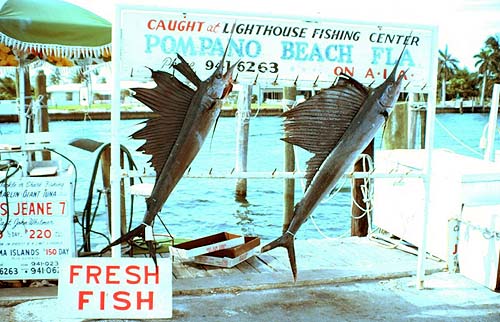
In the Atlantic, sailfish has little value as a commercial fishery, with the meat being relatively tough and rarely sold unless smoked. However, the sailfish is highly sought after by recreational fishermen. Popular fishing locations include Bermuda, Puerto Rico, Windward Islands, and the Gulf of Mexico. Atlantic sailfish are usually hooked by trolling, with either whole mullet or ballyhoo as bait.
In the Indo-Pacific, sailfish are taken as bycatch by commercial tuna longliners. They are also caught with driftnets, harpoons, and by trolling by commercial fishers.
Conservation Status
The National Marine Fisheries Service manages the sailfish under the authority of the Magnuson-Stevens Fishery Conservation and Management Act to insure the long-term sustainability of fishery stocks. Currently all U.S. flagged commercial vessels are prohibited from selling, retaining, or purchasing Atlantic billfish including sailfish. Recreational fishers must obtain a permit from NOAA fisheries for fishing in federal waters and state regulations may also apply. The minimum size limit for sailfish of 63 inches (160 cm) lower jaw fork length applies shoreward of the outer boundary of the U.S. Exclusive Economic Zone.
> Check the status of the sailfish at the IUCN website.
The IUCN is a global union of states, governmental agencies, and non-governmental organizations in a partnership that assesses the conservation status of species.
Geographical Distribution
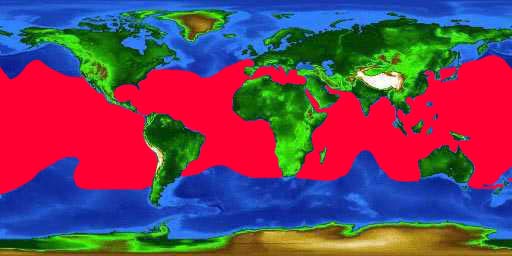
The sailfish is distributed from approximately 40° N to 40° S in the western Atlantic Ocean and from 50° N to 32° S in the eastern Atlantic Ocean. It has been taken in the Mediterranean Sea, although few records exist for this region. In the western Atlantic Ocean, its highest abundance is in the Gulf of Mexico, the Atlantic coast of Florida, and the Caribbean Sea. In this region, distribution is apparently influenced by wind conditions as well as water temperature. In the northern and southern extremes of the its distribution, sailfish appear during warm seasons. These seasonal changes in distribution may be directly linked to prey movement. In the eastern Atlantic Ocean, there is an aggregation off the coast of West Africa.
In the Pacific Ocean, the sailfish is widely distributed in temperate and tropical regions. It resides in waters from 45° to 50° N to 35° S in the western Pacific and from 35° N to 35° S in the eastern Pacific. Sailfish are especially abundant off Papua New Guinea and the Philippines as well as from Tahiti to the Marquesas and off Hawaii. This species may also be found in the Indian Ocean to approximately 35-45° S latitude.
Habitat
The Atlantic sailfish swims in the surface epipelagic and oceanic waters. It generally remains above the thermocline, in water temperatures between 70° and 83°F (21° to 28° C). There is evidence that it also swims into deeper water. It is less oceanic than other billfishes, making frequent forays into nearshore water.
Biology
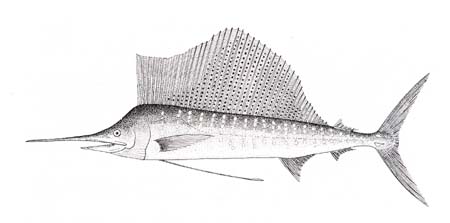
Distinctive Features
The upper jaw is modified into a long bill which is circular in cross section. This upper jaw is approximately twice the length of the lower jaw. Two dorsal and anal fins are present. The first dorsal fin is large, much taller than the width of the body. This large fin runs most of the length of the body, with the longest ray being the 20th. The first anal fin is set far back on the body. Second dorsal and anal fins approximately mirror one another in size and shape. Both are short and concave. The pectoral and pelvic fins are long with the pelvic fins almost twice as long and nearly reaching the origin of the first anal fin. The pelvic fins have one spine and multiple soft rays fused together. A pair of grooves run along the ventral side of the body, into which the pelvic fins can be depressed. The caudal peduncle has double keels and caudal notchs on the upper and lower surfaces. The lateral line is readily visible.

Coloration
Body color is variable depending upon level of excitement. The body is dark blue dorsally and white with brown spots ventrally. About 20 bars, each consisting of many light blue dots, are present on each side. The fins are all generally blackish blue. The anal fin base is white. The first dorsal fin contains many small black dots, which are more common towards the anterior end of the fin.
Size, Age, and Growth
The sailfish is one of the smaller members of the family Istiophoridae. The maximum size for the sailfish from the Atlantic region is 124 inches (340 cm) total length and around 128 pounds (100 kg). The all-tackle record listed by International Game Fish Association (IGFA) is (100 kg). In southern Florida, the fish tend to be smaller, generally between 68-90 inches (173-229 cm) total length. Commercial longline vessels in the Atlantic generally catch fish of 49-83 inches (125-210 cm) in length. The largest fish are usually females.
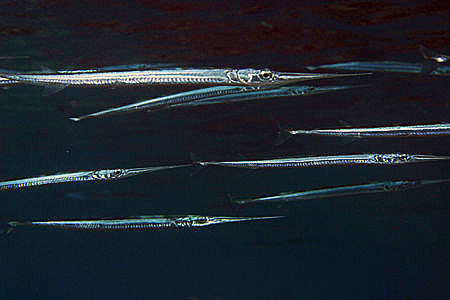
In waters of the Pacific Ocean, the maximum size for the sailfish is recorded at 134 inches (340 cm) total length and around 220 pounds (100 kg) in weight.
Food Habits
Cephalopods (squid and octopus) and bony fishes are the primary prey items of the sailfish in the Atlantic Ocean. Mackerels, tunas, jacks, halfbeaks, and needlefish are the most commonly taken fishes. These prey items indicate that some feeding occurs at the surface, as well as in midwater, along reef edges, or along the bottom substrate.
Sailfish in the Pacific region feed on fishes and cephalopods including squid. Fishes consumed include sardines, achovies, jacks, dolphin, ribbonfish and triggerfish.
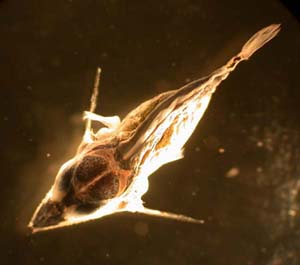
Reproduction
In the western North Atlantic Ocean, spawning may begin as early as April, but occurs primarily during the summer months. Females swim slowly through shallow water, with their dorsal fin above the water surface. One or more males will accompany her and spawn near the surface. Spawning may also occur in deep waters along the coast of North America and over the continental shelf off the West African coast. Spawning has been observed year-round in the eastern Atlantic, with a peak in the summer months. A large female may release 4,500,000 eggs while spawning. Atlantic sailfish are approximately 0.125 inches (0.3 cm) at hatching. Larval sailfish lack the jaw characteristic of the adults. The head contains many spines: one above the eye, on the lower operculum, and smaller one located between these. At 0.25 inches (0.6 cm), the jaws begin to elongate. At 8 inches (20 cm), all larval characteristics have disappeared and the juvenile has all the features of an adult. During the first year of life, young fish can often be observed off the coast of Florida. At six months, a juvenile may weight 6 lbs (2.7 kg) and be 4.5 feet (1.4 m) long. Upon reaching this size, growth rate decreases.
In the waters of the Pacific Ocean, sailfish appear to spawn in tropical and subtropical regions, with localized peaks during summer months. The males and females swim in pairs or two to three males pursue a female during spawning.
Predators
Dolphinfish and other large predatory fishes as well as seabirds feed on the sailfish.
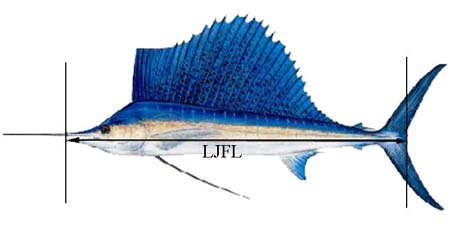
Parasites
A total of 34 parasitic species have been recorded from the sailfish, including the Atlantic Ocean and Pacific Ocean range of sailfish. Parasites include protozoans, digenea (flukes), didymozoidea (tissue flukes), monogenea (gillworms), cestoda (tapeworms), nematoda (roundworms), acanthocephala (spiny-headed worms), copepods, barnacles, and isopods. Ectoparasitic fish consist of pilotfish (Naucrate ductor), cookiecutter shark (Isistius brasiliensis), white suckerfish (Remora albescens), spearfish remora Remora brachyptera, marlin sucker Remora osteochir, and common remora (Remora remora).
Taxonomy
Shaw and Nodder first described the Atlantic sailfish in 1792 and assigned it the species name Xiphias platypterus. Some scientists believe that the Atlantic and Pacific sailfishes are separate species and apply the name I. albicans to the Atlantic form. Other names that have been used for this species include Histiophorus americanus, H. albicans, H. granulifer, H. indicas, H. orientales, H. pulchellus, Makaira velifera, Skeponopodus guebucu, H. granulifer, Xiphias velifer, Istiophorus amarui, I. americanus, I. brookei, I. gladius, I. grayii, I. immaculatus, I. ludibundus, I. wrighti, I. maguirei, and I. volador.
Prepared by: Susie Gardieff